|
Going Crackers
by Bob Brooke
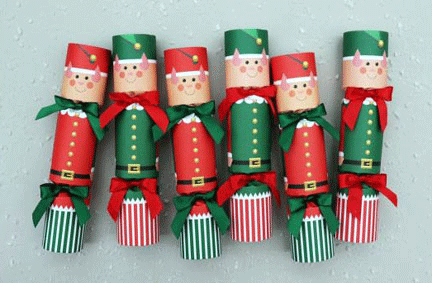 Crackers
are one of Britain’s greatest traditions. Formerly only seen and enjoyed
in the United Kingdom, Ireland, Australia, Canada, New Zealand and South
Africa, their quirkiness has lately appeared in British T.V. shows, such
as “All Creatures Great and Small” here in the U.S. and elsewhere. Crackers
are one of Britain’s greatest traditions. Formerly only seen and enjoyed
in the United Kingdom, Ireland, Australia, Canada, New Zealand and South
Africa, their quirkiness has lately appeared in British T.V. shows, such
as “All Creatures Great and Small” here in the U.S. and elsewhere.
No festive British dining table would be complete without crackers. Each
year, people gather around and politely ask the person sitting next to
them if they would pull a cracker. Then out floats the corny jokes, the
even more tacky gifts and, of course, the unflattering colored tissue
paper hats, worn during a festive dinner and dating back to Roman
Saturnalia celebrations. Collecting unused crackers has gained in
popularity and would never have been possible if it weren’t for
confectioner Tom Smith.
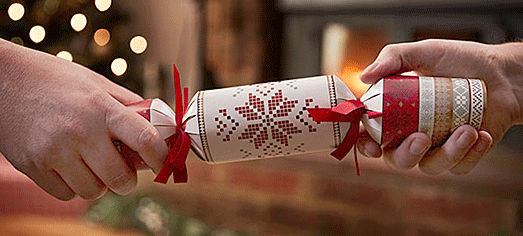
Each cracker consists of a segmented cardboard tube wrapped in a
brightly decorated twist of paper with a prize in the center, making it
resemble an oversized sweet-wrapper. It takes two people to pull one
apart, each holding an outer chamber, causing the cracker to split
unevenly and leaving one person holding the central chamber and prize. A
mild bang or crackle, produced by friction on a shock-sensitive,
chemically impregnated card strip, accompanies the split.
Cracker History
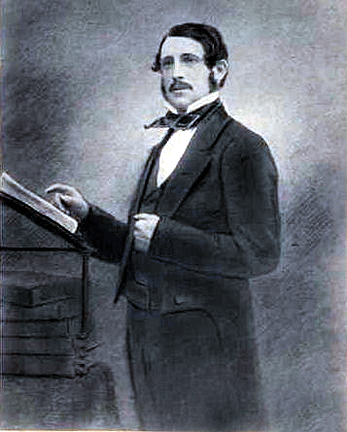 It
was Tom Smith of London who invented crackers in 1847. He discovered the
“bon-bon,” a sugared almond sweet, while on a trip to Paris in the
1840s. Wrapped in twists of colored paper he realized this sweet would
sell well in London. Until then, confectioners sold sweets loose in
small paper bags. His bon-bon was a huge success but only over the
Christmas holiday, but once the festive season ended, sales stopped. It
was Tom Smith of London who invented crackers in 1847. He discovered the
“bon-bon,” a sugared almond sweet, while on a trip to Paris in the
1840s. Wrapped in twists of colored paper he realized this sweet would
sell well in London. Until then, confectioners sold sweets loose in
small paper bags. His bon-bon was a huge success but only over the
Christmas holiday, but once the festive season ended, sales stopped.
To encourage orders year round, Smith added a small love moto which he
placed within the sweet’s wrapper. But sales remained brisk only around
Christmas so he decided to develop his seasonal sweet wrapping. Smith
had a flash of inspiration one day after he had thrown a log onto his
burning fire and a big crackle exploded from it. This sound was the
necessary spark that he had been looking for in order to enhance his
“bon bon” and make it more desirable to buyers.
 In
order to add the crackler mechanism, Smith had to increase the size of
the paper wrapper. He eventually dropped the sweet and replaced it with
a trinket: fans, jewelry and other substantial items. He marketed his
new product as the Cosaque, French for Cossack, because the noise made
was similar to the sound of the Cossack’s cracking whips.as they rode
through Paris during the French and Prussian Wars. But soon "cracker"
became the commonly used name. In
order to add the crackler mechanism, Smith had to increase the size of
the paper wrapper. He eventually dropped the sweet and replaced it with
a trinket: fans, jewelry and other substantial items. He marketed his
new product as the Cosaque, French for Cossack, because the noise made
was similar to the sound of the Cossack’s cracking whips.as they rode
through Paris during the French and Prussian Wars. But soon "cracker"
became the commonly used name.
After two years , Smith discovered that if he pasted a strip of
saltpeter to two pieces of thin card at each end, the friction of
pulling would create a spark and then a crack. He experimented a lot and
sometimes they burst into flames. By 1860, Smith had finally perfected
his cracks resulting in the birth of his “Bangs of Expectation.”
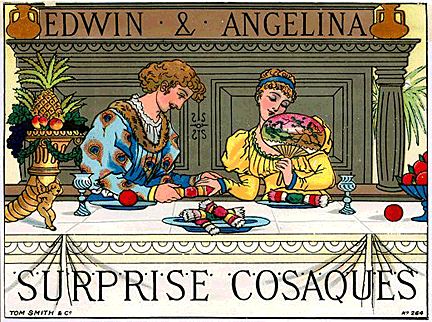 Smith’s
Cosaques were such a huge success that he took the idea overseas.
Unfortunately, this was a bad move since one Eastern manufacturer stole
it, copied it and shipped a consignment of crackers to Britain just
before Christmas. Smith was horrified but wouldn’t be beaten, so he set
about designing eight different varieties of cracker, working day and
night with his staff. This time his crackers were ready to be
distributed across the country in time for Christmas. After this, Smith
became the largest manufacturer of crackers. Smith’s
Cosaques were such a huge success that he took the idea overseas.
Unfortunately, this was a bad move since one Eastern manufacturer stole
it, copied it and shipped a consignment of crackers to Britain just
before Christmas. Smith was horrified but wouldn’t be beaten, so he set
about designing eight different varieties of cracker, working day and
night with his staff. This time his crackers were ready to be
distributed across the country in time for Christmas. After this, Smith
became the largest manufacturer of crackers.
Early Crackers
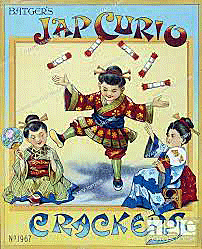 Throughout
the Victorian period boxes of crackers had many themes, with Japanoserie
being one of the most prolific. Inspired by the popular operas of the
time, such as Madame Butterfly and The Mikado, these cracker boxes
featured images of Japanese Geisha girls and inside the surprises were
miniature versions of Japanese pottery. These Japanese inspired crackers
continued right through to the outbreak of World War I and Tom Smith
crackers often featured Oriental themes. Throughout
the Victorian period boxes of crackers had many themes, with Japanoserie
being one of the most prolific. Inspired by the popular operas of the
time, such as Madame Butterfly and The Mikado, these cracker boxes
featured images of Japanese Geisha girls and inside the surprises were
miniature versions of Japanese pottery. These Japanese inspired crackers
continued right through to the outbreak of World War I and Tom Smith
crackers often featured Oriental themes.
Smith often used topical events such as the ‘Votes for Women;
Suffragettes. For this, he produced two different boxed sets—the “anti”
packs which made fun of the women and the “pro” packs, which joined
allegiance with the women, made in the purple, green and white house
colors of the Suffragette movement.
In 1884, Smith introduced “The ‘Bank of Love” crackers, a popular choice
with young people holding parties as the crackers box depicted a bank
where they could find love. So if the party hosts or guests were looking
for a potential wife or husband, these crackers were the perfect ice
breaker. Smith also reissued the same design as the “Toy Bazaar” and
“Lowther Arcade.”
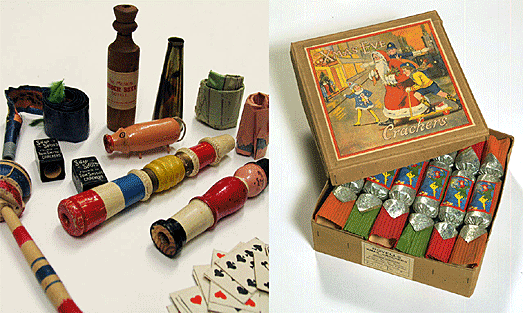
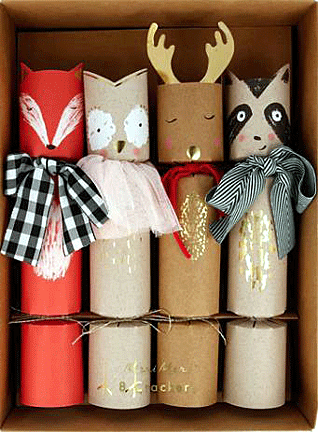 The
early 20th Century brought with it a variety of new ideas for cracker
box imagery and the crackers themselves. In November 1922, archaeologist
Howard Carter discovered King Tut’s Tomb in the Valley of the Kings.
This discovery fueled the public’s interest in Egyptology, including
Egyptian images on boxes of crackers that contained contained miniature
mummy cases. The
early 20th Century brought with it a variety of new ideas for cracker
box imagery and the crackers themselves. In November 1922, archaeologist
Howard Carter discovered King Tut’s Tomb in the Valley of the Kings.
This discovery fueled the public’s interest in Egyptology, including
Egyptian images on boxes of crackers that contained contained miniature
mummy cases.
Smith created another popular cracker in the early 1930s, entitled “Our
Charming Prince,” which depicted Britain’s future King, Edward VIII.
Each crimson gelatine cracker contained either a small miniature bust of
His Majesty, a jockey cap, miniature stirrups, racing horses, motor
cars, and even cigarettes.
War Time Crackers
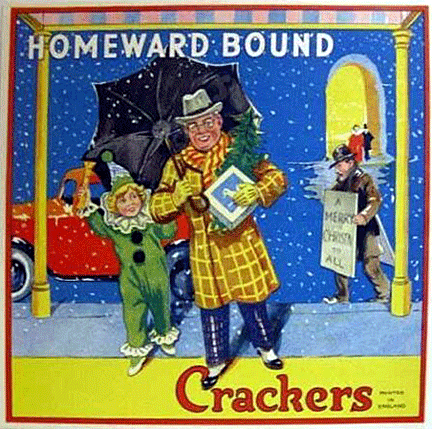 World
War II placed restrictions on cracker production. The Ministry of
Defence asked Smith to fold and tie bundles of his crackers together
with special string and official regulation knots. The agency then used
these bundles for training soldiers in armed combat since the sound made
when a soldier pulled the string replicated the sound of gunfire. World
War II placed restrictions on cracker production. The Ministry of
Defence asked Smith to fold and tie bundles of his crackers together
with special string and official regulation knots. The agency then used
these bundles for training soldiers in armed combat since the sound made
when a soldier pulled the string replicated the sound of gunfire.
Before stopping production of these wartime crackers, the distributors
Cecil Coleman Ltd sent them to members of the British armed forces based
overseas for a “job well done.” The members of the RAF each received an
Air Force blue and silver bon-bon cracker decorated with a sticker of a
Spitfire airplane. Today, these are very rare and highly prized by
collectors.
Post War Crackers
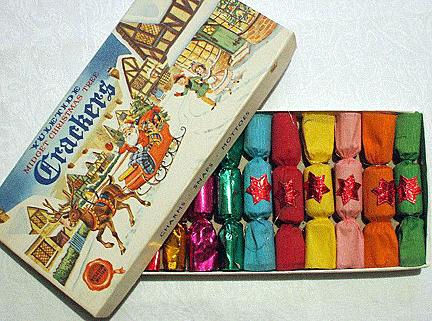 After
World War II, crackers became plain and simple, and it wasn’t until the
Coronation of Queen Elizabeth II in 1953 that imagery on cracker boxes
became popular again. Since that time, designs for crackers have focused
on television shows, celebrities, and blockbuster films. Today, crackers
continue to feature a variety of themes, from gardening and wildlife to
board games. After
World War II, crackers became plain and simple, and it wasn’t until the
Coronation of Queen Elizabeth II in 1953 that imagery on cracker boxes
became popular again. Since that time, designs for crackers have focused
on television shows, celebrities, and blockbuster films. Today, crackers
continue to feature a variety of themes, from gardening and wildlife to
board games.
Being a popular collectible has also encouraged cracker makers to
produce special boxes of crackers, geared exclusively towards the
collectors’ market.
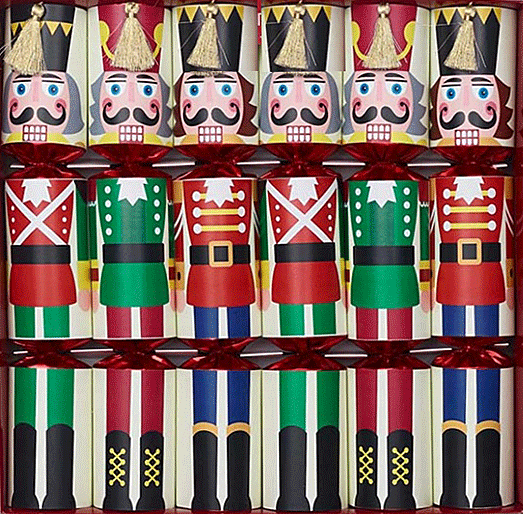
Cracker Collecting
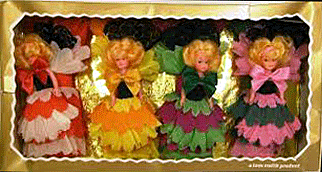 When
it comes to collecting crackers, there are a few key things collectors
look for. First and foremost is that the crackers have never been
pulled. Second is the design on the cracker and the box imagery, as well
as what novelties can be found inside. Both define the rareabilty.
Condition is also important, and the better the condition—not too much
fading to the crackers or box, no tears and still with their surprises
inside—the more they’re worth. When
it comes to collecting crackers, there are a few key things collectors
look for. First and foremost is that the crackers have never been
pulled. Second is the design on the cracker and the box imagery, as well
as what novelties can be found inside. Both define the rareabilty.
Condition is also important, and the better the condition—not too much
fading to the crackers or box, no tears and still with their surprises
inside—the more they’re worth.
< Back
to Collectibles Archives Next
Article >
|
